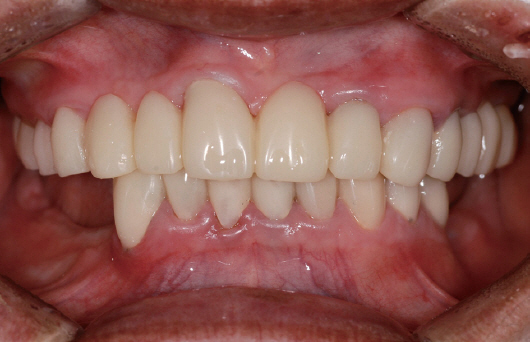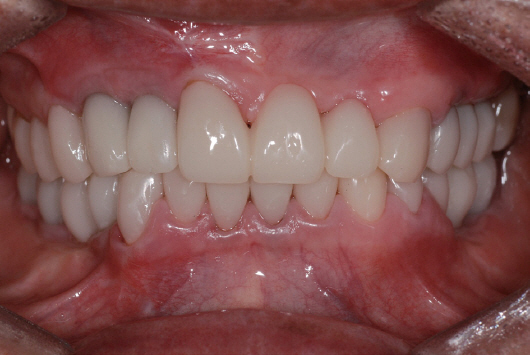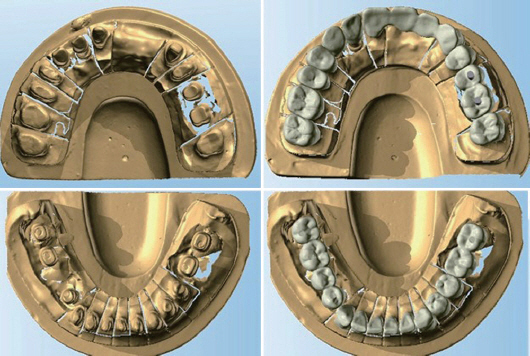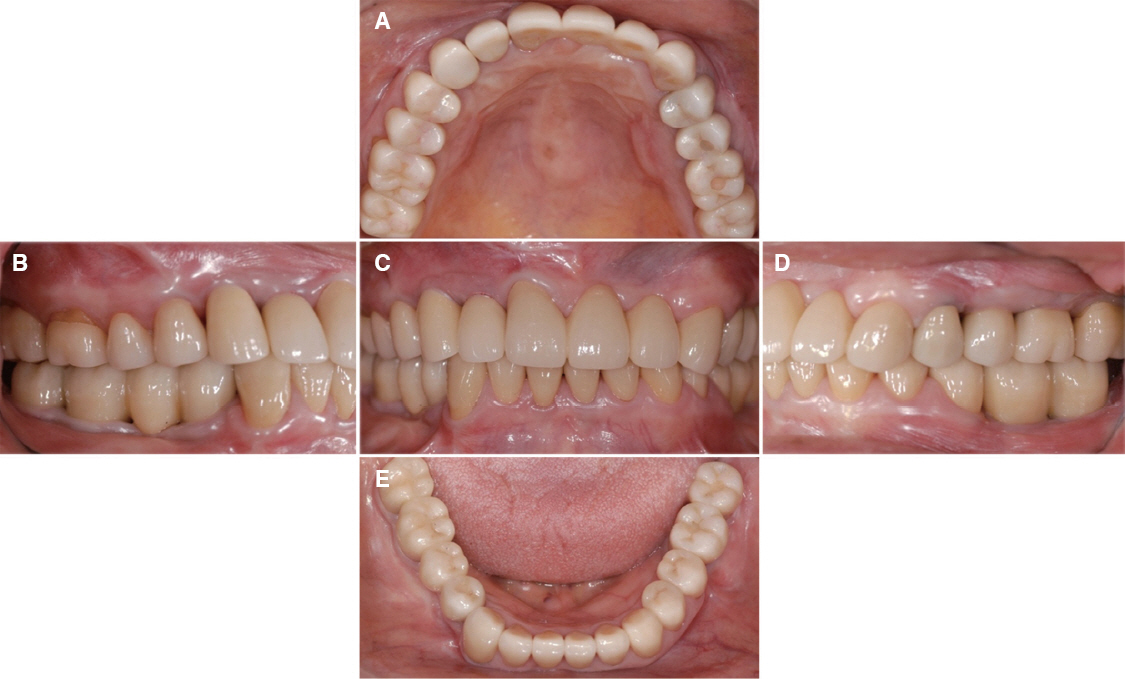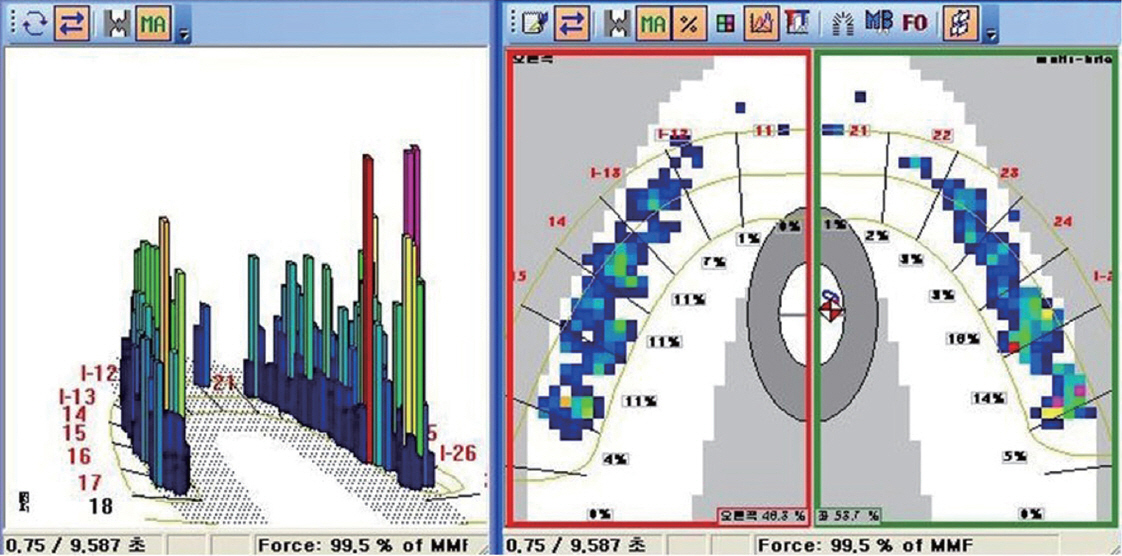J Dent Rehabil Appl Sci.
2015 Sep;31(3):231-241. 10.14368/jdras.2015.31.3.231.
A full-mouth rehabilitation using zirconia all-ceramic crowns: a case report
- Affiliations
-
- 1Department of Prosthodontics, School of Dentistry and Institute of Oral Bio-Science, Chonbuk National University, Jeonju, Republic of Korea. jmseo@jbnu.ac.kr
- 2Department of Dentistry, School of Medicine, Eulji University, Daejeon, Republic of Korea.
- KMID: 2180024
- DOI: http://doi.org/10.14368/jdras.2015.31.3.231
Abstract
- As patients' esthetic expectations increase, there is an increase in demand for cosmetic restorations of anterior and posterior teeth that resemble the natural tooth morphology and color. An example of high-strength all-ceramic systems is zirconia with CAD/CAM application. This case report describes a full-mouth rehabilitation using zirconia all-ceramic crowns supported by upper and lower implants and by a minimal increase in the occlusal vertical dimension in a patient with severe abrasion due to loss of posterior teeth.
Keyword
Figure
Reference
-
References
1. Anusavice KJ. Recent developments in restorative dental ceramics. J Am Dent Assoc. 1993; 124:72–4. 76-8, 80-4. DOI: 10.14219/jada.archive.1993.0031. PMID: 8429187.2. Bagby M, Marshall SJ, Marshall GW Jr. Metal ceramic compatibility: a review of the literature. J Prosthet Dent. 1990; 63:21–5. DOI: 10.1016/0022-3913(90)90259-F.3. Campbell SD. A comparative strength study of metal ceramic and all-ceramic esthetic materials: modulus of rupture. J Prosthet Dent. 1989; 62:4769. DOI: 10.1016/0022-3913(89)90184-4.4. Kelly JR. Dental ceramics: current thinking and trends. Dent Clin North Am. 2004; 48:513–30. DOI: 10.1016/j.cden.2004.01.003. PMID: 15172614.5. McLaren EA. All-ceramic alternatives to conventional metal-ceramic restorations. Compend Contin Educ Dent. 1998; 19:307–8. 310, 312 passim; quiz 326.6. Guess PC, Schultheis S, Bonfante EA, Coelho PG, Ferencz JL, Silva NR. All-ceramic systems: laboratory and clinical performance. Dent Clin North Am. 2011; 55:333–52. DOI: 10.1016/j.cden.2011.01.005. PMID: 21473997.7. Vult von Steyern P, Carlson P, Nilner K. All-ceramic fixed partial dentures designed according to the DC-Zirkon technique. A 2-year clinical study. J Oral Rehabil. 2005; 32:180–7. DOI: 10.1111/j.1365-2842.2004.01437.x. PMID: 15707428.8. Bouri A, Bissada N, Al-Zahrani MS, Faddoul F, Nouneh I. Width of keratinized gingiva and the health status of the supporting tissues around dental implants. Int J Oral Maxillofac Implants. 2008; 23:323–6. PMID: 18548930.9. Zigdon H, Machtei EE. The dimensions of keratinized mucosa around implants affect clinical and immunological parameters. Clin Oral Implants Res. 2008; 19:387–92. DOI: 10.1111/j.1600-0501.2007.01492.x. PMID: 18266873.10. Wood GN. Centric relation and the treatment position in rehabilitating occlusions: a physiologic approach. Part II: The treatment position. J Prosthet Dent. 1988; 60:15–8. DOI: 10.1016/0022-3913(88)90341-1.11. Fayz F, Eslami A. Determination of occlusal vertical dimension: a literature review. J Prosthet Dent. 1988; 59:321–3. DOI: 10.1016/0022-3913(88)90182-5.12. Abduo J. Safety of increasing vertical dimension of occlusion: a systematic review. Quintessence int. 2012; 43:369–80. PMID: 22536588.13. Ozkurt Z, Kazazoğlu E. Clinical success of zirconia in dental applications. J Prosthodont. 2010; 19:64–8. DOI: 10.1111/j.1532-849X.2009.00513.x. PMID: 19754642.14. Bachhav VC, Aras MA. Zirconia-based fixed partial dentures: a clinical review. Quintessence Int. 2011; 42:173–82. PMID: 21359252.15. Al-Amleh B, Lyons K, Swain M. Clinical trials in zirconia: a systematic review. J Oral Rehabil. 2010; 37:641–52. DOI: 10.1111/j.1365-2842.2010.02094.x.16. Choi BK, Han JS, Yang JH, Lee JB, Kim SH. Shear bond strength of veneering porcelain to zirconia and metal cores. J Adv Prosthodont. 2009; 1:129–35. DOI: 10.4047/jap.2009.1.3.129. PMID: 21165268. PMCID: PMC2994690.
- Full Text Links
- Actions
-
Cited
- CITED
-
- Close
- Share
- Similar articles
-
- Full mouth rehabilitation using monolithic zirconia: a clinical report
- Marginal fit of the digident CAD/CAM zirconia ceramic crowns
- Full mouth rehabilitation using zirconia crown in severe worn dentition: a case report
- Fracture strength of zirconia ceramic crowns according to tooth position
- Full mouth rehabilitation of a patient with tooth wear and insufficient restorative space due to loss of posterior teeth support: a case report





